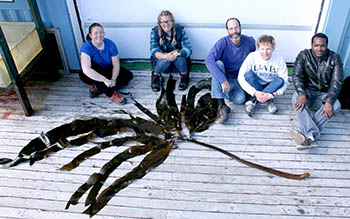
I suppose that anyone who has once been with a hero would always want to be with one again. From 1968 until 1984, Palmer Station and US Antarctic research on the Antarctic Peninsula was supported by a beautiful 125 ft. in length, wooden research vessel called the Hero. Maggie sailed on the Hero during her first two seasons at Palmer in the early 80s and I was at the ship's decommissioning ceremony in California in 1984. You can see more about the Hero at the Hero page on PalmerStation.com.
The Hero was replaced by the Polar Duke, which I sailed on my first season here in 1985-86 and then by the Laurence M. Gould which just transported our group down to Palmer. Both were and are much more capable oceanographic vessels, but for some things like diving, whale research, field camp support, and similar "low tech" missions, a smaller vessel like the Hero was equally as good. In fact for getting close to shore, the 14 ft. draft (how deep the hull extends below the surface) of the Hero was even better. So lots of us in the US Antarctic science community have been hoping that there would be enough demand to justify another vessel of that size for Antarctic science.
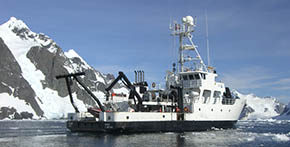
Enter the Point Sur, which is a member of the National Science Foundation's (NSF) main (everywhere-but-Antarctica) research vessel fleet. The Pt. Sur is based out of Moss Landing Marine Lab in California and is very similar to the Hero in size, being 135 ft. in length and having a draft of only 9 ft. This year NSF decided to have the Pt. Sur come to the Peninsula as a test. The groups working here were able to submit requests with justification to use her during this test year, and our group was fortunate to be selected.
In our normal work from Palmer Station, we do our diving from rubber Zodiac boats that we launch from the station. The maximum distance we can safely go from the station is a bit over two miles. That gives us access to lots of small islands that are wonderful places to collect and do experiments, but we are always in the market for an opportunity to compare what we find here to places further away. On a couple of occasions over the years, the L.M. Gould has had some open time that we were allowed to use to do just that.
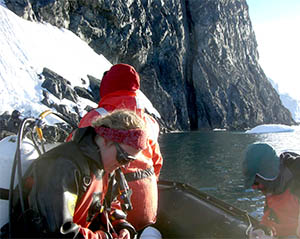
In early March 2010, our group had such an opportunity to make some exploratory dives from the Gould in the Lemaire Channel, which is about 40 miles east of Palmer. The Lemaire is possibly the most beautiful spot on the entire Antarctic Peninsula if not the continent as a whole, but that is not the reason we have wanted to get back there to dive ever since. When we were there, we found a most unusual macroalga (seaweed) that was so special that we have been looking for a way to get back and study it further.
In the system that people use to classify organisms, the highest level is considered to be the Domain. There are only three (Bacteria, Archaea, and ours, the Eukaryotes). Next comes Kingdom, although just how many there are an how one defines and organizes them are in a state of flux. Below that comes Phylum, Class, Order, Family, Genus, and Species. There are lots of genera with only one species and some families with only one genus and species. But I know of only one Order with only a single species. That is the brown algal Order Ascoseirales with the single species Ascoseira mirabilis, which is found only here in Antarctica. Although Ascoseira is a large brown alga, like the other large brown algae here it is not technically a "kelp" but is very much kelp-like in appearance.
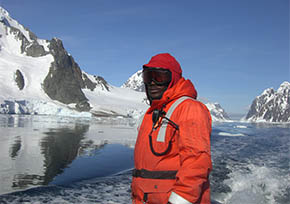
When we were in the Lemaire in 2010, we found a very unusual form of Ascoseira. Unlike the normal form, it has a very long stipe, which is the term in an alga for its "stem" or "stalk". This unusual form has been reported only once before, in very brief passing with a photograph in a paper by my colleague Dick Moe, who is at the University of California at Berkeley. That was our quarry, and as you can see in the group photo of us back here at Palmer with one of them, we were successful.
To have that success, we packed up our dive equipment including 16 scuba tanks on Wednesday afternoon and loaded it all onto the Pt. Sur. At 7:30 on Thursday morning we boarded the ship for the four hour trip over to the Lemaire. Not too long after lunch, we were motoring our Zodiac up the Channel to our first dive site.
What makes the Lemaire so beautiful is that it is a very tight channel with sheer vertical rock cliffs that rise straight up for over a thousand feet. Those cliffs extend very deep beneath the surface too, at least for our normal maximum depth of 130 ft. When we drop into the water a few feet from the cliffs, we are already in very deep water.
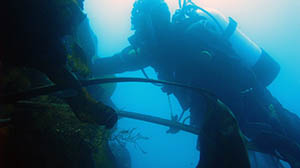
Along the underwater cliffs are the unusual Ascoseira. We made counts of its abundance at three sites and Kate took underwater photographs of it (including the one here) in addition to measurements of its photosynthetic ability with a special instrument we have for that purpose.
We returned to Palmer first thing on Saturday morning and spent the rest of the morning cleaning our dive gear and doing initial processing of the Ascoseira we collected. Julie will be doing some biophysical measurements of those unusual stipes and we will be preserving some of the algae to deposit in permanent taxonomic collections at various museums and other academic institutions.
Beautiful place. Successful science. Great team effort. As the saying goes, it is "good work if you can get it." I'm very lucky to be here with these wonderful people doing these exciting things. Good work indeed.